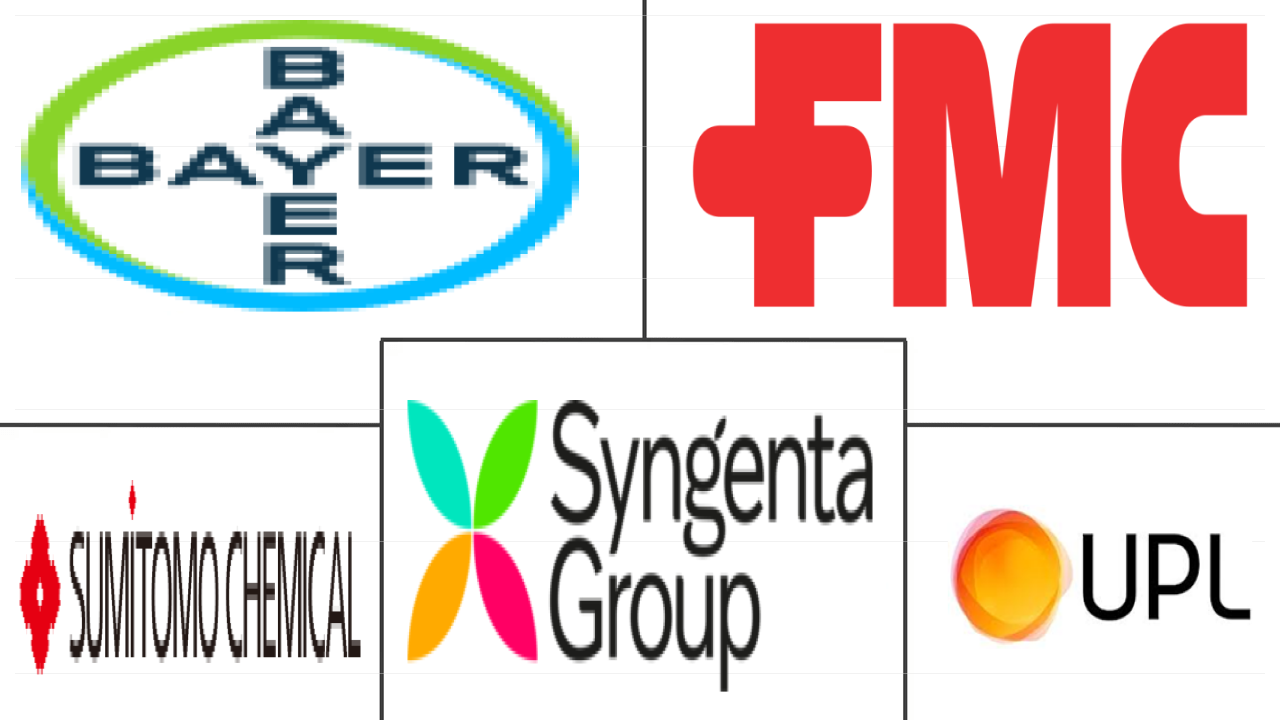Market Size of vietnam herbicide Industry
| Icons | Lable | Value |
|---|---|---|
|
|
Study Period | 2017 - 2029 |
|
|
Market Size (2024) | USD 361.4 Million |
|
|
Market Size (2029) | USD 459.6 Million |
|
|
Largest Share by Application Mode | Soil Treatment |
|
|
CAGR (2024 - 2029) | 4.92 % |
|
|
Fastest Growing by Application Mode | Soil Treatment |
|
|
Market Concentration | Low |
Major Players |
||

|
||
|
*Disclaimer: Major Players sorted in no particular order |
Vietnam Herbicide Market Analysis
The Vietnam Herbicide Market size is estimated at 361.4 million USD in 2024, and is expected to reach 459.6 million USD by 2029, growing at a CAGR of 4.92% during the forecast period (2024-2029).
361.4 Million
Market Size in 2024 (USD)
459.6 Million
Market Size in 2029 (USD)
7.33 %
CAGR (2017-2023)
4.92 %
CAGR (2024-2029)
Largest Segment by Application Mode
46.45 %
value share, Soil Treatment, 2023
Soil treatment herbicides offer a convenient and efficient solution by effectively targeting weed roots, leading to their growth disruption and eventual elimination.
Largest Segment by Crop Type
64.74 %
value share, Grains & Cereals, 2023
Grains and cereals are grown over a larger area than other crops, making them more prone to weed infestations such as barnyard grass, nutsedge, and Leptochloa.
Fastest-Growing Segment by Crop Type
5.13 %
Projected CAGR, Fruits & Vegetables, 2024-2029
The prevalence of broadleaf weeds is causing significant losses in vegetable crops in the country. Farmers are adopting herbicides to effectively eliminate weeds.
Leading Market Player 1
8.26 %
market share, UPL Limited, 2022

UPL Limited manufactures a wide range of herbicides based on nine active ingredients, including pretilachlor, metsulfuron methyl, metazosulfuron, quizalopop, and clethodim.
Leading Market Player 2
7.40 %
market share, Bayer AG, 2022

Bayer partnered with Oerth Bio with the aim of developing next-generation crop protection products based on Oerth Bio's innovative protein degradation technology.
Traditional herbicide soil treatments and their effectiveness in protecting the quality of major crops may raise soil treatment adoption
- In Vietnam, herbicides are applied through various modes to control weeds in agricultural practices effectively. Farmers can achieve cost savings by utilizing suitable modes of application, allowing them to apply herbicides, effectively covering specific areas, and minimizing wastage. This increased efficiency leads to optimized herbicide usage, resulting in reduced input costs for farmers.
- In 2022, the dominant mode of herbicide application in agricultural practices was soil application, accounting for 46.4% of the overall herbicide application segment. The grains & cereals segment held the largest market share at 64.6%. The preference for soil treatment herbicides is attributed to their effectiveness in protecting the quality of grains and cereals by preventing or reducing weed growth.
- In 2022, foliar application was the second leading and held a market share of 33.2% in the segment of herbicide application. This is due to foliar herbicides being beneficial due to their fast-acting properties, which can rapidly disrupt the physiological processes of targeted weeds. This swift action results in symptoms like wilting, yellowing, or necrosis in the weeds. This advantage is valuable when tackling aggressive or competitive weed species that have the potential to rapidly dominate the crops if not effectively controlled.
- In the Vietnamese agricultural sector, the utilization of herbicides is aimed at maximizing crop productivity and improving overall crop profitability. The mode of application of herbicides is projected to register a CAGR of 4.9% in terms of market share.
Vietnam Herbicide Industry Segmentation
Chemigation, Foliar, Fumigation, Soil Treatment are covered as segments by Application Mode. Commercial Crops, Fruits & Vegetables, Grains & Cereals, Pulses & Oilseeds, Turf & Ornamental are covered as segments by Crop Type.
- In Vietnam, herbicides are applied through various modes to control weeds in agricultural practices effectively. Farmers can achieve cost savings by utilizing suitable modes of application, allowing them to apply herbicides, effectively covering specific areas, and minimizing wastage. This increased efficiency leads to optimized herbicide usage, resulting in reduced input costs for farmers.
- In 2022, the dominant mode of herbicide application in agricultural practices was soil application, accounting for 46.4% of the overall herbicide application segment. The grains & cereals segment held the largest market share at 64.6%. The preference for soil treatment herbicides is attributed to their effectiveness in protecting the quality of grains and cereals by preventing or reducing weed growth.
- In 2022, foliar application was the second leading and held a market share of 33.2% in the segment of herbicide application. This is due to foliar herbicides being beneficial due to their fast-acting properties, which can rapidly disrupt the physiological processes of targeted weeds. This swift action results in symptoms like wilting, yellowing, or necrosis in the weeds. This advantage is valuable when tackling aggressive or competitive weed species that have the potential to rapidly dominate the crops if not effectively controlled.
- In the Vietnamese agricultural sector, the utilization of herbicides is aimed at maximizing crop productivity and improving overall crop profitability. The mode of application of herbicides is projected to register a CAGR of 4.9% in terms of market share.
| Application Mode | |
| Chemigation | |
| Foliar | |
| Fumigation | |
| Soil Treatment |
| Crop Type | |
| Commercial Crops | |
| Fruits & Vegetables | |
| Grains & Cereals | |
| Pulses & Oilseeds | |
| Turf & Ornamental |
Vietnam Herbicide Market Size Summary
The Vietnam herbicide market is experiencing a steady growth trajectory, driven by the increasing need for effective weed management in agricultural practices. Farmers in Vietnam are adopting various modes of herbicide application, such as soil and foliar treatments, to optimize crop productivity and reduce input costs. The preference for soil application is particularly notable due to its effectiveness in protecting grains and cereals, which hold a significant share of the market. The adoption of genetically modified herbicide-tolerant crops, such as GM corn, has further contributed to the rising consumption of herbicides, as these crops require specific weed control measures to maximize yield and profitability. The persistent nature of weeds, coupled with changing agricultural practices, necessitates the use of multiple herbicides with diverse modes of action, thereby fueling market growth.
The market landscape is characterized by a fragmented structure, with major players like Bayer AG, FMC Corporation, Sumitomo Chemical Co. Ltd, Syngenta Group, and UPL Limited holding a significant portion of the market share. These companies are actively engaging in partnerships and collaborations to enhance crop protection technologies and develop eco-friendly solutions. The demand for herbicides is also influenced by environmental factors, such as weather conditions that promote weed growth, leading to increased application rates and higher prices for active ingredients. The market's growth is further supported by ongoing research and development efforts aimed at improving herbicide efficacy and expanding the range of available solutions to meet the evolving needs of Vietnamese agriculture.
Vietnam Herbicide Market Size - Table of Contents
-
1. MARKET SEGMENTATION (includes market size in Value in USD and Volume, Forecasts up to 2029 and analysis of growth prospects)
-
1.1 Application Mode
-
1.1.1 Chemigation
-
1.1.2 Foliar
-
1.1.3 Fumigation
-
1.1.4 Soil Treatment
-
-
1.2 Crop Type
-
1.2.1 Commercial Crops
-
1.2.2 Fruits & Vegetables
-
1.2.3 Grains & Cereals
-
1.2.4 Pulses & Oilseeds
-
1.2.5 Turf & Ornamental
-
-
Vietnam Herbicide Market Size FAQs
How big is the Vietnam Herbicide Market?
The Vietnam Herbicide Market size is expected to reach USD 361.43 million in 2024 and grow at a CAGR of 4.92% to reach USD 459.55 million by 2029.
What is the current Vietnam Herbicide Market size?
In 2024, the Vietnam Herbicide Market size is expected to reach USD 361.43 million.

